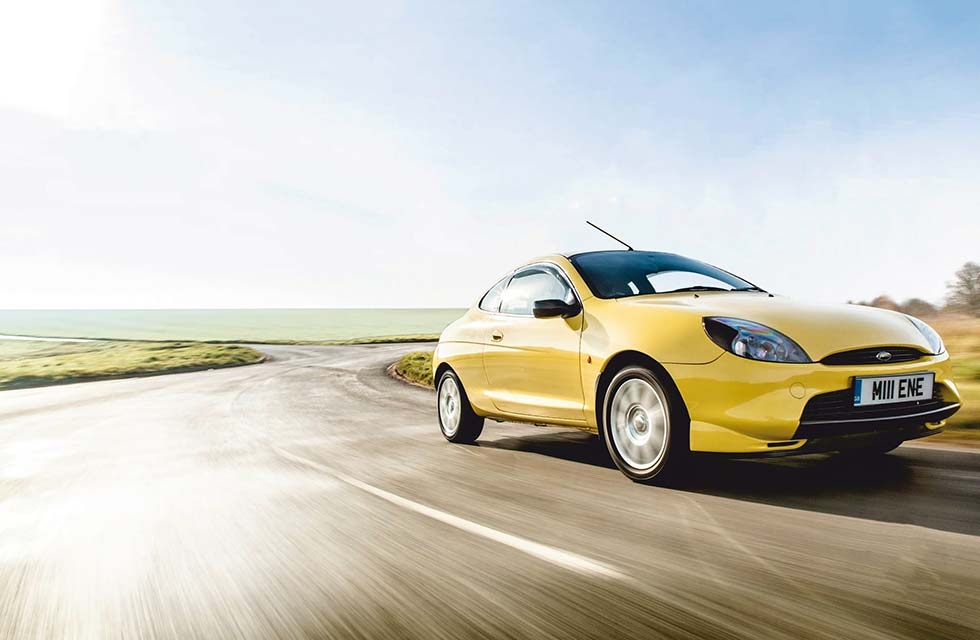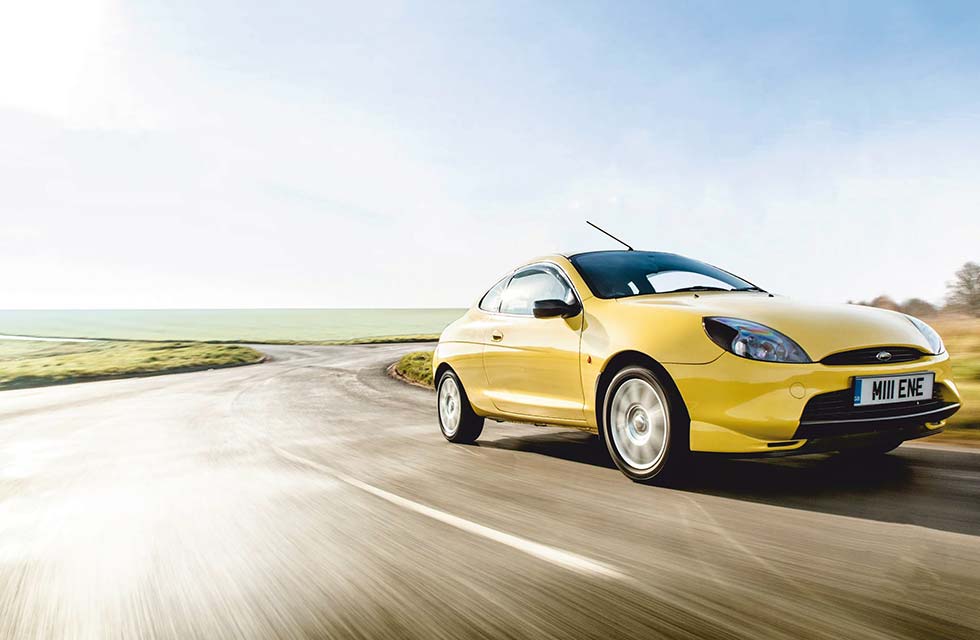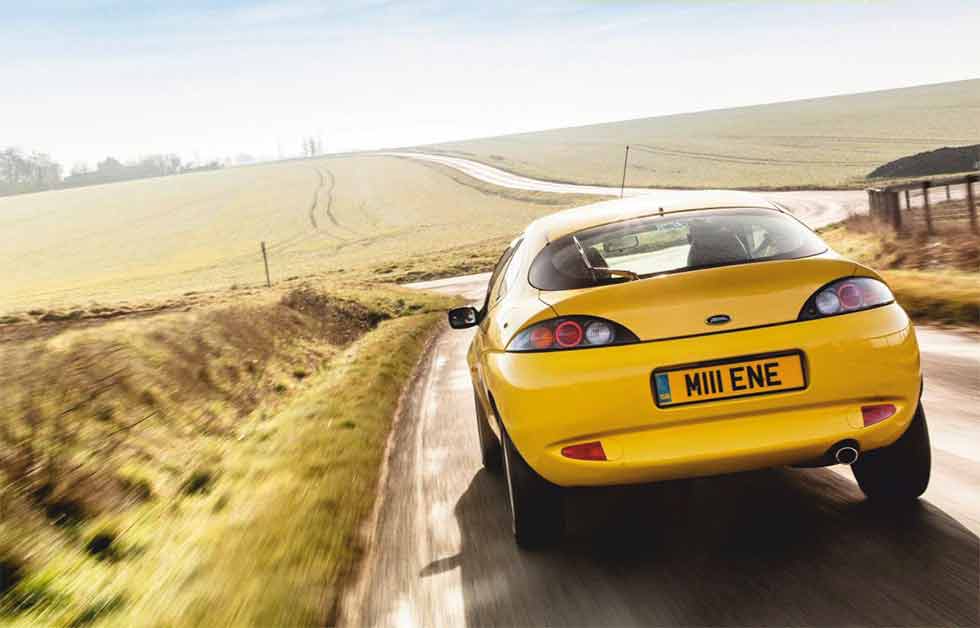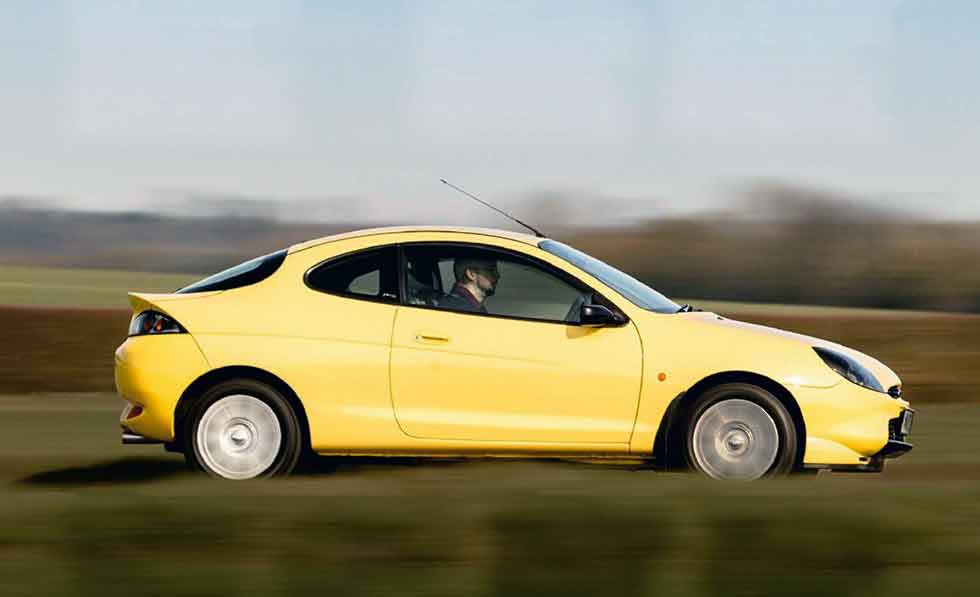
Why now’s the time to pounce on a Ford Puma. The Ford Puma, one of the 90s’ greatest handling cars, is becoming collectable. Words Nathan Chadwick & JJ Vollans. Photography Adam Shorrock.
CLEVER MONEY CARS
VALUE NOW 2019 £3000
VALUE IN 2024 £6000
Ford Puma Fast, funandset to appreciate: you need to pounce on one now.
Time to Pounce
The 1990s wasn’t a great era for new hot hatches, mainly because car manufacturers were scared off by exorbitant insurance premiums. It was a great era for everyday coupés, though. You’re looking at one of the finest of the lot – the Ford Puma. Okay, so its underpinnings were based on humble Fiesta mechanicals, but the Puma quickly earned a reputation as one of the finest-handling B-road heroes around.

‘THE FORD PUMA IS ONE OF THE 1990s’ VERY FINEST CARS’
Because it was a Ford, parts and servicing were cheap, and the Blue Oval sold hat-fuls of them. Sadly, like most of Uncle Henry’s fleet, rust prevention was a bit of an afterthought. That, plus the ravages of neglect and scrap-page, have led to dramatic numbers of cars disappearing into the ether. Between 2017 and 2018, 1900 cars bade farewell to the DVLA’s computer. There are just 6000 left out of some 50,000 UK cars sold – a stat that should both alarm and twitch an eyebrow. Will the Puma be the next fast Ford trend?
As we write this article, there’s interesting news all over the car-centred internet. Ford is building another Puma.
Rather predictably, however, it’s not a light, revvy coupé with bags of character. It’s a 1.0-litre crossover SUV with all the desirability of piles. Funnily enough, it looks like it came from someone’s arse too.

Rather than dwell on it, let’s celebrate the original Puma. Its underpinnings may have been based on a MkIV Fiesta but that’s a bit like saying that a real puma is based on your tabby housecat. Under the watch of lead engineer Richard Parry-Jones, the Puma became not just a job for its developers, designers and engineers, but away of life.
There are tales of the Puma’s distinctive look being perfected in record time between Christmas and New Year 1993/1994. The designers were so committed, design chief Claude Lobo had to actively force his staff to go home each night so that Ford wouldn’t break the working hours limit. Then there are rumours of road-testing carried out in the dead of night, from Essex B-roads to the south of France, for ‘secrecy reasons’.
The other reason was that the engineers and road-testers couldn’t resist having ‘just one more go’. It’s a car built by enthusiasts, then. Despite the earliest examples now approaching 24 years old, that passion still shines through from the second you palm the gearknob into first.
While we’re on the subject, that knob is your interaction with one of the best gear-changes of the era. It’s a traditional rod-change set-up with a short throw that, when in good order, feels like the stick is directly acting on the cogs. Such is the reassuring clunk and speed with which ratios can be swapped, you’ll relish changing gear just for the sake of it. There are a few plastic bits that can wear in the linkage, however, so if the change feels less than ideal, this is where to start replacing parts.
Three engines were offered; a 1.4, a 1.6 and, by far the most enticing, the 1.7. The Zetec engine was co-produced with Yamaha, and the Puma’s unit was very special indeed. The Zetec-SE VCT had variable cam timing on the intake, and was novel for the time, with a plastic ladder style main bearing and crankcase assembly, forged big-end bearing caps and powder-forged connecting rods. Then the engine was tuned in Germany to provide the right sound. The 1.7-litre motor was bespoke to the Puma, and had Nikasil coatings added by Yamaha.
Bury the throttle into the floor and the power is delivered in trademark twin-cam-engine style –which is to say it’s a peaky blighter.
You can certainly sense a renewed urgency as the revs climb over 4000rpm,with peak power coming at 6300rpmand the redline eventually arriving at 6750rpm.
The Puma feels surprisingly quick and that’s largely because it makes the most of its modest firepower. It may have only 123bhp – but in a car that weighs just over a ton this goes a long way. Because all the controls are so communicative and there’s a lack of sound-deadening, the sense of speed is so much greater than the reality.
Ford also had to keep in mind the car’s insurability. When launched, it was clear there was potential for more power – realized with the later Racing Puma, which we covered in the September Drive-My 2018 front page.
Anyway, the Puma was never about autobahn-blasting top speeds. Parry- Jones is of Welsh descent, and there are few things Welsh engineers like more than rallying. Rallying is all about grip, poise, and using just the right amount of power to make effective slingshots between the trees.
You can see that DNA in the Puma. The MkIV Fiesta was a night and day improvement over the insipid MkIII, but the Puma was further honed. The spring rates were stiffened and a new, thicker anti-roll bar was deployed. The bushes were also revised and the track widened. Add in a kerbweight of 1040kg and you’ve got the great basis for a fine-handling car. And it worked. Boy, did it work.
The Puma is huge fun to drive – it’s so light and chuckable. There’s a sense that it’s always ready and willing to change direction, yet it remains very stable, even when you’re being slightly silly with your inputs. Body roll is negligible even when pushing hard – evidence that those suspension and chassis mods did the trick. Quick B-road progress can be made by whipping the Puma into a corner, carrying huge speed; then, backing off as the rear rotates slightly, the nose is left pointing at the apex. Back on the power early, you soon see why some 80 or so of the later Racing Pumas got an optional limited-slip differential.
Even with an open diff the Puma is A magnificent B-road companion, but you can’t help wishing for that extra traction pulling you out of the corner earlier –which would make it peerless. The stock Puma chassis is so good it encourages you to be greedy with the throttle, which in extremis causes the front end to begin to push wide.
The steering is light but remains on the right side of over-assisted, especially as with increased speed the assistance dials back automatically. There’s so much feedback that you feel completely confident in driving flat-out after the first five minutes.
You always know how much grip is on offer. It even allows you to adjust mid-corner, releasing or increasing lock as you feel grip come and go. Compared to other small coupés of the time, the Puma was a revelation.
Although Vauxhall’s Tigra precipitated the Puma’s development, the Griffin machine is about as much fun as force-fed repeats of Homes Under The Hammer. Only the Renault Mégane Coupé came close, but its engine lacks the sparkle of the Puma’s. Add to all this that Ford’s wonder coupé is now becoming rare, it’s telling that both the Tigra and Megane Coupé are nearly extinct. Us Brits loved them, accounting for 50,000 of the 130,000 production run. A lot of that was down to the looks.
The second model from Ford’s New Edge design programme after the Ka, it’s about as perfectly proportioned as a small coupé can be. Short overhangs fore and aft keep the wheelbase long enough for stability and cabin space – though sitting in the back is really only the preserve of children or masochist adults, there’s good room up front. As befits the Puma name, there are cat-like influences in the front and rear lights. It’s more kitten than claws-out tomcat – again, that would be addressed with the later Racing Puma. This ‘kitten-ness’ concerned some of the Ford team even as the car was launched.
That’s despite a stunning TV advert starring the king of masculine cool, the rather dead Steve McQueen, recreating Bullit around the streets of San Francisco. Though superbly made, it’s still a controversial decision all these years later, judging by the bile in the Youtube comments.
Over time, much like the Mazda MX-5, the Puma became subject to hairdresser jibes. True enthusiasts can see through this ill-informed bluster, of course, but it has helped to suppress values. Without the cult of JDM and drifting (yo), the Puma has yet to crawl out of the bargain basement like the Mazda.
That’s not the only similarity between the MX-5 and the Puma – they both resist rust in the same fashion. As in, they don’t. The ability of the Puma to turn itself completely brown before disappearing entirely, and the lack of a more mainstream petrolhead following, means that finding an unblemished low-mileage car is already hard. With the numbers dropping dramatically every year, that task will only become more difficult. Good Pumas will become expensive – like the XR2is and RS Turbos of yore.
The car you see before you is one of several special editions – something of a fast Ford market catnip. This is a Millennium Edition, conceived to celebrate Ford winning the Design Council’s Millennium Products award. With Zinc Yellow paint and Alchemy Blue leather interior, just 1000 were built. Now just 164 are left, making it probably one of the most desirable ‘normal’ Pumas of the lot.
Whichever Puma you buy – we strongly suggest you go straight for the 1.7-litre version – you’ll be able to revel in a car built with such passion and enthusiasm, you can feel it clearly from behind the wheel.
RWD-only snobs may sneer but this is one of the finest-handling, most engaging, most entertaining cars on the road – and for now, it’s cheaper than a set of special alloys on a mid-range Beemer. So what are you waiting for?
The Modern Classics view
Finding a good Ford Puma will be a challenge – it’s best to go through the Ford Puma group on Facebook or the Project Puma forum. Get to know owners, immerse yourself in the scene and be ready to pounce – good cars rarely reach the open market. It really is worth your patience – the Puma is one of the 1990s’ very finest cars, and deserves a resurgence in fortune. These are great bargain fun mobiles, but before long the Ford market will wake up and smell the rarity. So the time to buy is now. Find a good one, keep the tin worm at bay and, most importantly, drive it like it was meant to be driven: hard. It seems to relish it.
Even though our Clever Money Cars series touches on the controversial ‘investment’ word, let’s put the short-term increase in value to one side. This is a cast-iron investment in your driving pleasure.

FORD PUMA 1.7
Engine 1697cc, 4-cyl, DOHC
Transmission FWD, 5-speed manual
Power 125bhp @ 6300rpm
Torque 116lb-ft @ 4500rpm
Weight 1039kg
PERFORMANCE
0-60mph 8.8sec
Top speed 126mph
Economy 38mpg
‘THE FORD PUMA IS ONE OF THE 1990s’ VERY FINEST CARS’
Ergonomically perfect cabin’s a great playpen. 1.7-litre Zetec engine co-produced with Yamaha. Millenium editions all came in retina-popping Zinc Yellow. Puma was a key part of Ford’s New Edge design programme.
WHAT TO PAY
Concours £5000
Good £2000
Usable £1000
Project £500
6000 UK cars left
‘WE DIDN’T WANT TO COPY THE TIGRA AND GO FOR LOOKS ALONE. WE WANTED POKE AND A DECENT CHASSIS’
Puma lead engineer Richard Parry-Jones talks about the car’s development.
‘The car came about because of two factors coinciding. Firstly, Vauxhall launched the Tigra, which was a very appealing Corsa-based car – and that got Ford thinking about where the market was heading. Secondly, Yamaha was helping us with the design of the 1.4-litre Zetec engine that went into the Focus and Fiesta. Yamaha had promised to design and build a high-performance 1.7-litre engine.

We didn’t want to copy GM and only build a car for looks alone –we wanted to make a car with poke and a decent chassis. ‘We agreed to launch with the 1.7-litre engine and later add the 1.4-litre for the style market.
Jacques Nasser [chairman of the board at Ford of Europe] instructed us to put together a proposal, and then a few design sketches. We had a good opportunity to reskin the excellent Fiesta chassis ,which didn’t need much fettling, and then we had the gift of the 1.7-litre engine. There weren’t many stipulations from bosses. It had to be true to the new Ford brand position. It had to be a good-quality car with excellent steering (mainly at my behest),with good ride and comfort. We also had to make sure the car was fast, but not too fast so it wasn’t too expensive to insure.
‘Getting the design right was the biggest challenge. The graphics [styling] on the front are low and Very wide, the grille and lights are pulling out to the corners to make it lower and wider. The rear window is similar to the Capri’s, and the rear quarter window helps to accelerate the lines of the fastback.
‘The second challenge was how to make the interior special without spending too much on design. We used machined aluminium on the gearknob, and enthusiasts loved it.
We also put a shorter throw on it to make it more sporting. The engine was smooth, and handling and chassis tuning went well. Tuning the tyres was very important. Nothing changed during development – it was a straight shot to market.
‘Looking back, we started galvanising cars around the Focus launch, so the Puma missed out. Even if I’d wanted to galvanise it, I wouldn’t have been able to – small cars weren’t typically used for this.
‘Perhaps we shouldn’t have called it the Puma –maybe it should have been the Fiesta Coupé or the Fiesta ST Coupé. Having a different name helped the Ford brand, but it didn’t help the Fiesta brand.
‘The idea of using Steve McQueen in the launch video was exciting. We asked the family and they were very helpful.
‘We launched the car in southern Germany. Journalists couldn’t believe how rapidly it could be hustled across country. Once it got on to real roads it shone, and it was very satisfying to hear feedback from journalists. ‘It’s a car I’m very proud of.’
DEALER VIEW WAYNE LAMPORT, STONE COLD CLASSICS
Wayne (stonecoldclassics.com) believes that the Ford Puma has a bright future ahead of it over the next five years.
‘They can only go up in value – as rust and neglect relegate the remaining cars to the scrapheap, low-mileage cherished survivors will become increasingly valuable,’ he says.
‘Once previous owners remember just how well their old Pumas drove they will hanker for another – and the old supply-versus- demand scenario will inevitably kick in.’
Wayne sees all Pumas becoming desirable, whatever’s under the bonnet. ‘The 1.7was particularly sweet but the difference between the 1.4 and 1.7 is not that great so they will all be in demand,’ he says. ‘Enthusiast owners often forget that not everyone cares about ultimate performance. At sane speeds a 1.4-litre car is still as much fun as a 1.7-litre one; the chassis really is that good.’
A Millennium Edition like our car is his tip of the special editions. ‘Lots of people love a yellow car so The Millennium edition will surely be coveted.’
Similarly loud colours are also well worth seeking out among the ranks of the normal Pumas, Wayne believes. ‘Red, blue and of course yellow are all great choices. ‘In my opinion, the Pumas look a little plain in silver, and yet that seemed to be the most common colour in period.’
NEED TO KNOW
The good news is that the Puma is A mechanically hardy little car that jujsust requires regular TLC. The bad news is the rust problems.
Among the key spots for corrosion are the rear wings, both inside and out, which can then go on to ravage the sills. Enterprising chaps use Peugeot 206 front wings as repair sections.
Ex-Pressed Panels (steel panels. co.uk) currently offer replacement sills. This being a 1990s’ Ford you really need to check everywhere for corrosion – and we really mean absolutely everywhere. It’s worth taking along a friendly club type. The Nikasil coating in the engine can cause problems with the Nickel in the cylinder bores reacting badly to the sulphur in British fuel on 1999 cars, but it’s likely that any issues that are likely to happen already have. Telltale sign is epic oil consumption, and it’s fairly terminal.
The inexpensive nature of the Puma is great for buying; but unless the owner is an enthusiast, it could be that the car has lived a hard, unloved life. The biggest killer of the 1.7 engine is poor oil maintenance. If the worst happens, replacement engines are available via eBay, currently at around £250-300. You may also have seen corners cut on tyres, which is not something you want to consider on your first B-road trip.
Look out for poor panel matching and overspray – a telltale sign the car has been in a crash.
I BOUGHT ONE JAMES KIRK
‘I ordered my Millennium Edition new in 1999. I love its fun, good looks, performance and handling. The cambelt needs an expensive change every five years, but servicing is otherwise cheap. Puma Speed and Puma build provide specialist upgrades. Spares can be expensive from Ford, but there are plenty of new and used bits on eBay. For online help, use projectpuma.comand pumapeople.com’
THE FINER POINTS
1 White dials – just like the Sierra Cosworths you dreamed about, and which featured in many an Escort MkIII Max Power binnacle swap.
2 Original nine-spoke alloys are handsome – well worth a refurb if they’re not immaculate.
3 Just 1000 of this edition were built. Fewer than a quarter remain on the road.
4 It plays a merry tune… and one you’ll absolutely relish.
5 Very supportive leather Recaros in Alchemy Blue are bespoke to the Millennium Edition.






